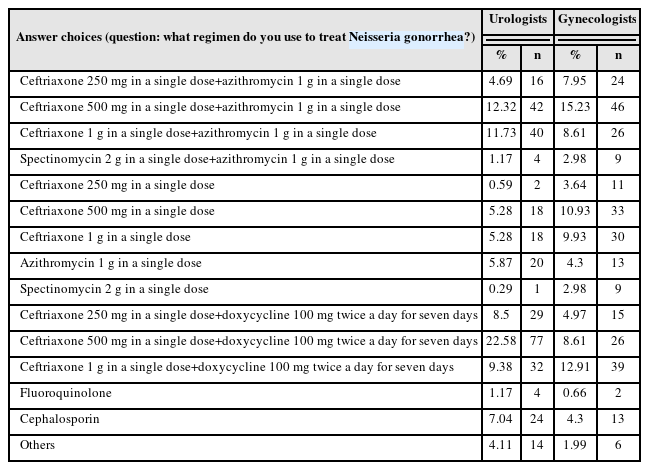Search
- Page Path
- HOME > Search
Original Article
- Trend Analysis of Sexually Transmitted Infection Treatments in Korea
- Soeon Park, Byung Kyu Han, Sangrak Bae, Seung-Ju Lee, Jin Bong Choi
- Urogenit Tract Infect 2024;19(2):25-30. Published online August 31, 2024
- DOI: https://doi.org/10.14777/uti.2024.19.2.25

-
 Abstract
Abstract
 PDF
PDF PubReader
PubReader ePub
ePub - Purpose: The revision of the 2023 Guidelines for the Treatment of Sexually Transmitted Infections (STIs) has been released. Hence, it is necessary to analyze the current status of STI treatments in Korea.
Materials and Methods: A questionnaire was distributed to urologists and gynecologists from December 2022 to January 2023 through an online survey program. Three hundred and forty-one urologists and 302 gynecologists responded to the questionnaire.
Results: For Neisseria gonorrhea treatment, ceftriaxone 500 mg and 100 mg of doxycycline twice daily for seven days were most preferred by urologists (22.58%). The treatment most preferred by gynecologists (15.23%) was 500 mg of ceftriaxone and 1 g of azithromycin in a single dose. Both urologists and gynecologists generally treat Chlamydia trachomatis according to the treatment guidelines. For treating Mycoplasma genitalium, 29.03% of urologists preferred administering azithro-mycin at 500 mg once daily, followed by 250 mg for four days. In contrast, 33.11% of gynecologists preferred doxycycline 100 mg twice daily for seven days.
Conclusions: Most urologists and gynecologists followed the treatments recommended in the 2nd edition of the STI treatment guidelines, revised in 2016. As many treatment regimens have changed because of the recent increase in antibiotic-resistant STIs, there is a need to encourage them to follow the new treatment guidelines.
- 5,725 View
- 36 Download

Review
- Is Human Mpox a New Sexually Transmitted Infection in Korea That Should Be Monitored?
- Gilho Lee
- Urogenit Tract Infect 2023;18(2):35-44. Published online August 31, 2023
- DOI: https://doi.org/10.14777/uti.2023.18.2.35
-
 Abstract
Abstract
 PDF
PDF Supplementary Material
Supplementary Material PubReader
PubReader ePub
ePub - Human monkeypox (mpox) outbreaks have been reported in more than 110 countries, with more than 86,930 confirmed cases. The World Health Organization has realized the seriousness of personal transmission and has declared a global health emergency against the infection. Traditionally, contact with infected animals in a few endemic countries has been a major transmission route of the mpox virus. On the other hand, the global mpox outbreak in 2022 has been primarily associated with sexual networks of men who have sex with men (MSM) and bisexual men exhibiting high-risk behaviors. Their common symptoms are initial fever, headache, swollen lymph nodes, and subsequent skin rashes. These presentations did not consistently occur in the 2022 outbreak. Many patients presented with skin lesions on the anogenital areas without prodromal symptoms. In addition, the atypical characteristics of the recent outbreak may result in a misdiagnosis of other skin lesions, such as chickenpox. Furthermore, infected persons are frequently co-infected with sexually transmitted infections (STIs) with similar skin lesions. The newly confirmed cases in Korea on April 2023 must have been infected through community transmission because these new patients had not traveled overseas in the past three months. Therefore, mpox is something that everybody should be concerned about in Korea. Medical practitioners must know the characteristics of the infection because patients with mpox may visit their offices with some genital lesions or other STIs. The clinical information from this paper may broaden and deepen the understanding of human mpox and curb the early transmission of the infection.
- 1,808 View
- 8 Download


 KAUTII
KAUTII
 First
First Prev
Prev


